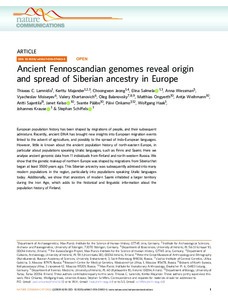Ancient Fennoscandian genomes reveal origin and spread of Siberian ancestry in Europe
Thiseas C. Lamnidis; Kerttu Majander; Choongwon Jeong; Elina Salmela; Anna Wessman; Vyacheslav Moiseyev; Valery Khartanovich; Oleg Balanovsky; Matthias Ongyerth; Antje Weihmann; Antti Sajantila; Janet Kelso; Svante Pääbo; Päivi Onkamo; Wolfgang Haak; Johannes Krause; Stephan Schiffels
Ancient Fennoscandian genomes reveal origin and spread of Siberian ancestry in Europe
Thiseas C. Lamnidis
Kerttu Majander
Choongwon Jeong
Elina Salmela
Anna Wessman
Vyacheslav Moiseyev
Valery Khartanovich
Oleg Balanovsky
Matthias Ongyerth
Antje Weihmann
Antti Sajantila
Janet Kelso
Svante Pääbo
Päivi Onkamo
Wolfgang Haak
Johannes Krause
Stephan Schiffels
NATURE PUBLISHING GROUP
Julkaisun pysyvä osoite on:
https://urn.fi/URN:NBN:fi-fe2021042720338
https://urn.fi/URN:NBN:fi-fe2021042720338
Tiivistelmä
European population history has been shaped by migrations of people, and their subsequent admixture. Recently, ancient DNA has brought new insights into European migration events linked to the advent of agriculture, and possibly to the spread of Indo-European languages. However, little is known about the ancient population history of north-eastern Europe, in particular about populations speaking Uralic languages, such as Finns and Saami. Here we analyse ancient genomic data from 11 individuals from Finland and north-western Russia. We show that the genetic makeup of northern Europe was shaped by migrations from Siberia that began at least 3500 years ago. This Siberian ancestry was subsequently admixed into many modern populations in the region, particularly into populations speaking Uralic languages today. Additionally, we show that ancestors of modern Saami inhabited a larger territory during the Iron Age, which adds to the historical and linguistic information about the population history of Finland.
Kokoelmat
- Rinnakkaistallenteet [27094]
